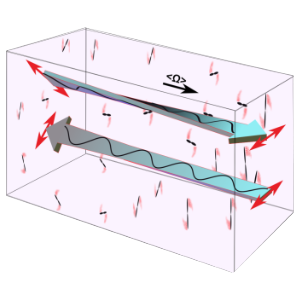Experiments on light dragging in a moving medium laid the cornerstones of modern physics more than a century ago and are still in the focus of current research. When linearly polarized light passes through a rotating dielectric, the plane of polarization slightly rotates – a phenomenon first studied by Fermi in 1923. It took half a century before this effect was first observed in mechanically rotated bulk optical specimens. The measured polarization drag angle does not surpass several microradians for typical nonresonant dielectric materials. Recently, we predicted [1] that the polarization drag effect (also known as the mechanical Faraday effect) may be dramatically enhanced if the light passes through a gas of fast-, unidirectionally-spinning molecular super-rotors. Several femtosecond-laser labs have already succeeded in optically creating such a medium. We showed that the specific rotation power of the super-rotor medium exceeds the previously observed values by many orders of magnitude. Following our proposal, the first observation of the polarization drag in a gaseous medium was reported in our joint work [2] with the group of Prof. V. Milner (UBC, Vancouver, Canada). Moreover, we demonstrated that time-resolved measurements of the polarization drag angle provide unique information about collisional relaxation in molecular gases and might reveal the details of the intermolecular potentials [3].

Linearly polarized light (twisted beams) propagating through a gas of unidirectionally spinning molecular super-rotors experiences rotation of the polarization plane. The polarization rotates in the same sense as the average molecular rotation.
- U. Steinitz and I. Sh. Averbukh, “Giant Polarization Drag in a Gas of Molecular Superrotors”,
Phys. Rev. A 101, 021404(R) (2020) - A. A. Milner, U. Steinitz, I. Sh. Averbukh, and V. Milner, “Observation of Mechanical Faraday Effect in Gaseous Media”, Phys. Rev. Lett. 127, 073901 (2021), Featured in Physics, Editors’ Suggestion
- I. Tutunnikov, U. Steinitz, E. Gershnabel, J.-M. Hartmann, A. A. Milner, V. Milner,
and I. Sh. Averbukh,
“Rotation of the polarization of light as a tool for investigating the collisional transfer of angular momentum from rotating molecules to macroscopic gas flows”,
Phys. Rev. Research 4, 013212 (2022)


